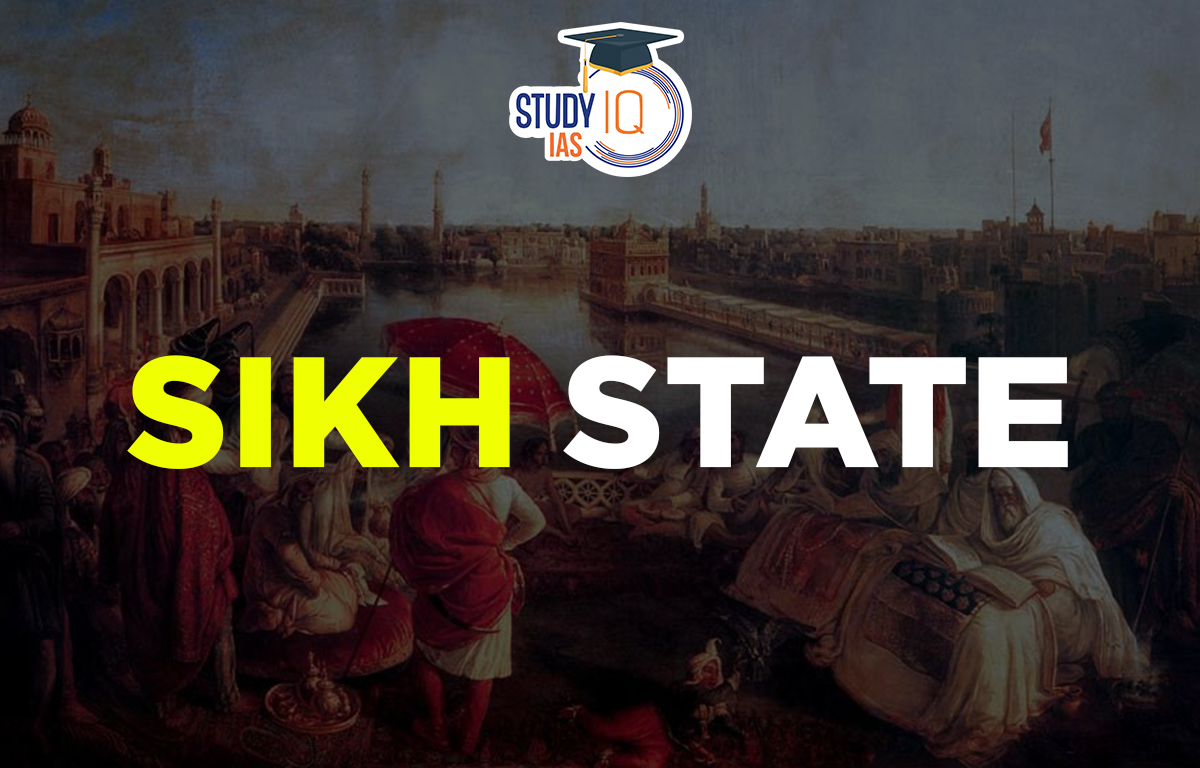Table of Contents
Sikh State
Read all about the Sikh State. Guru Nanak established the Sikh empire around the end of the 15th century. The Jat farmers and other lower castes of the Punjab were converted to the Sikh religion. Guru Hargobind initiated the Sikhs’ metamorphosis into a combative, militant group (1606-1645). However, it was under the guidance of Guru Gobind Singh (1664–1708), the Sikhs’ tenth and last Guru, that they rose to prominence as a political and military power.
Guru Gobind Singh engaged in continuous combat with Aurangzeb’s troops beginning in 1699. For the purpose of preparing for the UPSC Exam, read this article about the Sikh State.
Sikh States Administration
The Sikhs formed a number of bands called jathas and later misls in the eighteenth century under a variety of leaders. Their united forces were known as the enormous army (dal khalsa). During Baisakhi and Diwali, the entire body would gather in Amritsar to make choices collectively known as “resolutions of the Guru (gurmatas)”. Rakhi, a system that protects growers in exchange for a 20 percent levy on the crop, was implemented.
There were 12 misls of Sikhs, each of which served a distinct region of the province. The Misls were founded on the equality concept, with each member having an equal say in selecting how to run the organisation and choosing its leader and other officers. When a misl conquered new land, the spoils were divided among the members in proportion to how each one contributed to the conquest. The chief undoubtedly received the largest share.
The democratic nature of the Misls gradually vanished, and they were eventually ruled by strong rulers. These chiefs continuously fought with one another and established themselves as independent chieftains, which caused the khalsa’s feeling of brotherhood and togetherness to vanish as well.
Sikh States and MaharajaRanjit Singh
The English were concerned about a combined Franco-Russian invasion of India via land. . In 1807, Charles Metcalfe was sent to Lahore by Lord Minto. On the condition that the English remain neutral in the case of a Sikh-Afghan battle and acknowledge Ranjit Singh as the ruler of the entire Punjab, including the Malwa (Sutlej) provinces, Ranjit Singh accepted to Metcalfe’s proposal for an offensive and defensive alliance.
The negotiations failed, though. Ranjit Singh made the decision to ratify the Treaty of Amritsar (April 25, 1809) with the Company in a new political environment where the English had gained greater influence and the Napoleonic menace had subsided.
Sikh State Rise
Ranjit Singh’s administration was marked by reforms, modernisation, infrastructure investment, and overall prosperity. Sikhs, Hindus, Muslims, and Europeans all served in his Khalsa army and government. Along with other renowned gurudwaras like Takht Sri Patna Sahib in Bihar and Hazur Sahib Nanded in Maharashtra, his legacy includes the renovation of the Harmandir Sahib in Amritsar. This historical period saw a revival in Sikh culture and art.
Soldiers in his army came from a variety of racial and religious backgrounds. His army was highly efficient in terms of fighting, logistics, and infrastructure. There was a power struggle among his many relatives after his death in 1839. The decline of the Empire officially began at that point. The end of Ranjit Singh’s kingdom was formally signalled by his death in June 1839. Kharak Singh, his eldest legitimate son, succeeded him.
Anglo-Sikh War (1845–46)
According to legend, the Sikh army crossed the Sutlej River on December 11, 1845, starting the first Anglo-Sikh War. This was perceived as an aggressive action that justified England’s entry into the war. A power struggle for supremacy between the Lahore court and the ever-powerful and more local army culminated the unrest that broke out in the Lahore kingdom after Maharaja Ranjit Singh’s death.
The Sikh army developed mistrust as a result of the English military’s attempts to conquer Gwalior and Sindh in 1841 and the conflict in Afghanistan in 1842. An increase in the number of English soldiers deployed near the kingdom of Lahore’s border.
Sikh States Decline
Within ten years of Ranjit Singh’s passing, independent Sikh government in Punjab was abolished as a result of power struggles among the powerful Sikh chiefs and royal family disputes that made it relatively easy for the English to seize control.
Sikh States UPSC
Punjab and the rest of British India fell under the direct sovereignty of the British crown in 1858, under Queen Victoria’s Queen’s Proclamation. Up to Indian independence in 1947, the Sikhs fought on the British side during the Revolt of 1857 and a number of other actions and battles. This page contains comprehensive information on Sikh State for UPSC Preparation.


 Nagari Pracharini Sabha Revival: Backgro...
Nagari Pracharini Sabha Revival: Backgro...
 Ryotwari System in India, Features, Impa...
Ryotwari System in India, Features, Impa...
 Battle of Plassey, History, Causes, Impa...
Battle of Plassey, History, Causes, Impa...





















